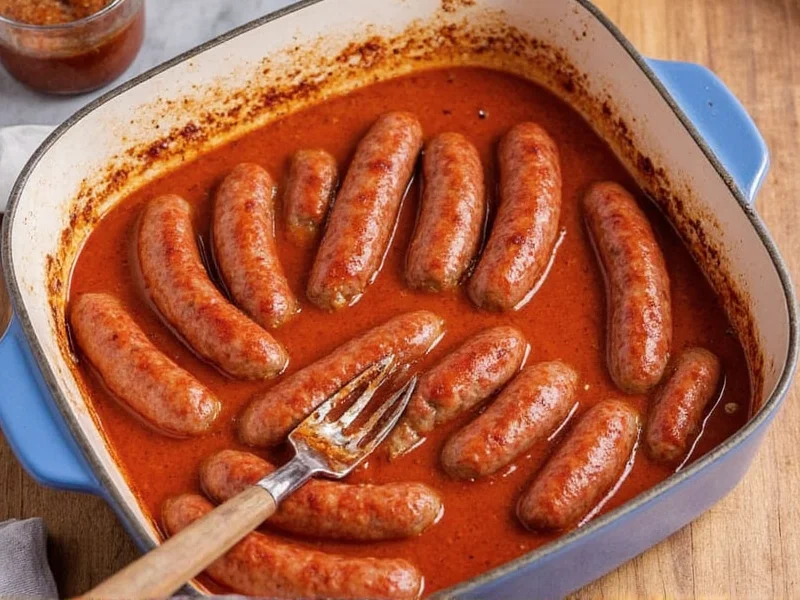Italian sausage typically needs 20-25 minutes to cook in a 400°F (200°C) oven. Always verify doneness by checking that the internal temperature reaches 160°F (71°C) using a meat thermometer, as cooking times can vary based on sausage thickness and oven accuracy.
Perfectly cooked Italian sausage delivers juicy, flavorful results without drying out or undercooking. The oven method provides consistent heat distribution that helps achieve that ideal golden-brown exterior while ensuring thorough cooking throughout. Unlike stovetop methods that require constant attention, oven cooking offers a hands-off approach that's perfect for busy weeknights or meal prep.
Factors That Affect Italian Sausage Cooking Time
While 20-25 minutes at 400°F serves as a reliable guideline, several variables influence the exact time needed for your specific situation:
- Sausage thickness - Thicker links require additional cooking time
- Oven calibration - Many home ovens have temperature variations
- Starting temperature - Refrigerated sausages need slightly longer than room-temperature
- Type of sausage - Sweet vs. hot Italian sausage cooks similarly, but chicken or turkey varieties have different requirements
- Rack position - Middle rack provides most even cooking
Step-by-Step Oven Cooking Instructions
Follow these professional kitchen-tested steps for perfectly cooked Italian sausage every time:
- Preheat your oven to 400°F (200°C) with the rack positioned in the center
- Line a rimmed baking sheet with parchment paper or aluminum foil for easy cleanup
- Arrange sausages in a single layer with space between each link for proper air circulation
- Optional: Lightly brush sausages with olive oil to enhance browning
- Place the baking sheet in the preheated oven
- Cook for 10 minutes, then carefully flip the sausages using tongs
- Continue cooking for another 10-15 minutes until fully cooked
- Remove from oven and let rest for 5 minutes before serving
| Sausage Thickness | Recommended Time | Internal Temperature |
|---|---|---|
| Standard links (1 inch) | 20-25 minutes | 160°F (71°C) |
| Thick links (1.5 inches) | 25-30 minutes | 160°F (71°C) |
| Sliced coins | 12-15 minutes | 160°F (71°C) |
| Chicken/turkey sausage | 18-22 minutes | 165°F (74°C) |
How to Verify Perfect Doneness
Time alone shouldn't be your only indicator of properly cooked Italian sausage. Use these reliable methods to confirm doneness:
The most accurate method involves using an instant-read meat thermometer. Insert it into the thickest part of the sausage, avoiding the casing. For traditional pork Italian sausage, the internal temperature must reach 160°F (71°C). Chicken or turkey varieties require 165°F (74°C).
Visual indicators include:
- Golden-brown exterior with slight charring in spots
- Clear juices when pierced (not pink or bloody)
- Firm texture that springs back slightly when pressed
- No pink color remaining in the center
Avoid cutting into sausages to check doneness, as this releases precious juices that keep them moist. If you must check visually, slice just one sausage and verify the internal color.
Common Mistakes to Avoid
Many home cooks make these preventable errors when cooking Italian sausage in the oven:
- Overcrowding the pan - This creates steam instead of allowing proper browning
- Not preheating the oven - Cold starts lead to uneven cooking and less browning
- Relying solely on time - Oven variations mean time is just a guideline
- Skipping the rest period - Resting allows juices to redistribute for maximum moisture
- Using too low a temperature - Below 375°F often results in dry, overcooked sausage
Serving Suggestions for Perfect Italian Sausage
Once properly cooked, Italian sausage shines in numerous preparations. For classic presentations, serve whole links with sautéed peppers and onions. Slice cooked sausage and add to pasta dishes, pizza, or hearty soups. The flavorful drippings collected on your baking sheet make an excellent base for sauces or to toss with roasted vegetables.
Consider these complementary pairings:
- Crusty bread to soak up delicious juices
- Simple arugula salad with lemon vinaigrette
- Garlic mashed potatoes or polenta
- Roasted bell peppers and mushrooms
Storage and Reheating Guidelines
Properly stored cooked Italian sausage maintains quality for future meals. Allow sausages to cool completely before transferring to an airtight container. Refrigerate for up to 4 days or freeze for up to 3 months.
For best reheating results:
- Oven method - 350°F for 10-15 minutes until heated through
- Skillet method - Medium heat with a splash of water to create steam
- Avoid microwave - Often makes casing tough and unevenly heats
Never partially cook sausage and refrigerate for later completion, as this creates food safety risks. Always cook to proper internal temperature in one continuous process.
Adapting for Different Oven Types
Convection ovens circulate hot air, reducing cooking time by approximately 25%. When using a convection setting, lower the temperature to 375°F and check for doneness after 15-20 minutes. Gas ovens often have hotter spots than electric models, so rotating the baking sheet halfway through cooking ensures even browning.
For those using toaster ovens or air fryers, the cooking time remains similar but requires closer monitoring due to the smaller cooking chamber and more intense heat concentration.











 浙公网安备
33010002000092号
浙公网安备
33010002000092号 浙B2-20120091-4
浙B2-20120091-4